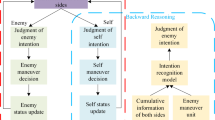Abstract
Three air target intention recognition methods based on deep learning are proposed to realize the function of recognizing air target intention based on real-time situation information to resolve the problem that pilots cannot effectively observe and analyze observation within a short period of time in complex air battlefield environments and traditional air target intention recognition algorithms have shortcomings such as complex feature filtering and reliance on expert experience. The methods use expert experience to simulate combat in the air on the simulation platform we designed, obtain and filter key posture information of aerial targets and corresponding expert script intention labels during combat, and sends them to a designed full connect network, a convolutional neural network and a recurrent neural network for training. The training results show that all three networks can achieve air target intention recognition, and the recurrent neural network based model can achieve the intention recognition with an accuracy of 80%. Compared with traditional methods, such as D-S inference, the proposed method is more general and robust. Finally, the feasibility and effectiveness of the method we proposed is verified by the simulation and experiments.











Similar content being viewed by others
Explore related subjects
Discover the latest articles, news and stories from top researchers in related subjects.References
Wei C, Qin LI, Di Z, Zhao X (2017) Research on fighter tactical intention recognition based on air combat. DEStech Trans Eng Technol Res. https://doi.org/10.12783/DTETR/3RD/AMMA2017/14770
Nayyar A, Le DN, Nguyen NG (eds) (2018) Advances in swarm intelligence for optimizing problems in computer science. CRC Press, Florida
Nayyar A, Nguyen NG (2018). Introduction to swarm intelligence. Advances in swarm intelligence for optimizing problems in computer science, 53–78
Nayyar A, Garg S, Gupta D, Khanna A (2018) Evolutionary computation: theory and algorithms. In Advances in swarm intelligence for optimizing problems in computer science (pp. 1–26). Chapman and Hall/CRC
Jieli L, Yuanjie H, Yanjiao D (2009) An effective combination rule of evidence theory in situation assessment. Electron Opt Control 16(10):80–83
Yan Yijun Fu, Yingjie QC (2007) Study on reconnaissance and Intelligence situation assessment technology. Radio Eng 37(4):17–20
Kadar L, Baron Uartian E (1987) Process modeling: a situation assessment expert system[C]. AIAA Computers in Aerospace Conf. Wakefield, MA, Oct
Chen Xu, Sen K (2006) Situation assessment of C4ISR information fusion system. Fire Cont Command Cont 31(4):5–9
Zhou R, Zhou-Yi YU, Chi P et al. (2005) Situation assessment in tactical decision aiding system[J]. Acta Simulata Systematica Sinica
Llinas J, Antony RT (1993) Blackboard concepts for data fusion application. Internat J Patt Recognit Artif Intell 7(2):285–308
Das S, Lawless D (2002) Trustworthy situation assessment via belief networks[C]. Proceed Infor Fus 1:543–549
Guo XB, Wang Z, Hu W (2005) Information fusion with bayesian networks for target recognition. J Sys Simulat 17(11):2713–2716
Weisheng Li, Baoshu W (2003) Situation assessment based on bayesian Networks. Infor Sys Eng 25(4):480–483
Lu C, An Z, Qiang W (2010) Research on situation assessment of UCAV based on dynamic bayesian networks in complex environment. LSMS/ICSEE 2010 Part II, LNCS 6329, pp. 58–68
LeCun Y, Bottou L, Bengio Y et al (1998) Gradient-based learning applied to document recognition[J]. Proc IEEE 86(11):2278–2324
Zaremba W, Sutskever I, Vinyals O (2014) Recurrent Neural Network Regularization[J]. Eprint Arxiv
Berner C, Brockman G, Chan B, et al. (2019) Dota 2 with large scale deep reinforcement learning[J]
Wu B, Fu Q, Liang J, et al. (2018) Hierarchical macro strategy model for MOBA game AI[J]
LeCun Y, Bengio Y, Hinton G (2015) Deep learning. Nature 521(7553):436
LeCun Y, Boser B, Denker JS et al (1989) Backpropagation applied to handwritten zip code recognition[J]. Neural Comput 1(4):541–551
Xu B, Wang N, Chen T, et al. (2015) Empirical Evaluation of Rectified Activations in Convolutional Network[J]. Computer ence
Ioffe S, Szegedy C (2015) Batch normalization: accelerating deep network training by reducing internal covariate shift[J]
Boureau YL, Ponce J, LeCun Y (2010) A theoretical analysis of feature pooling in visual recognition[C]//Proceedings of the 27th international conference on machine learning (ICML-10). 111–118
He K, Zhang X, Ren S, Sun J (2016) "Deep residual learning for image recognition," 2016 IEEE Conference on computer vision and pattern recognition (CVPR), Las Vegas, NV, 2016, pp. 770–778, doi: https://doi.org/10.1109/CVPR.2016.90
Hochreiter S, Schmidhuber J (1997) Long short-term memory. Neural Computat. https://doi.org/10.1162/neco.1997.9.8.1735
Author information
Authors and Affiliations
Corresponding author
Additional information
Publisher's Note
Springer Nature remains neutral with regard to jurisdictional claims in published maps and institutional affiliations.
Rights and permissions
About this article
Cite this article
Qu, C., Guo, Z., Xia, S. et al. Intention recognition of aerial target based on deep learning. Evol. Intel. 17, 303–311 (2024). https://doi.org/10.1007/s12065-022-00728-9
Received:
Revised:
Accepted:
Published:
Issue Date:
DOI: https://doi.org/10.1007/s12065-022-00728-9




